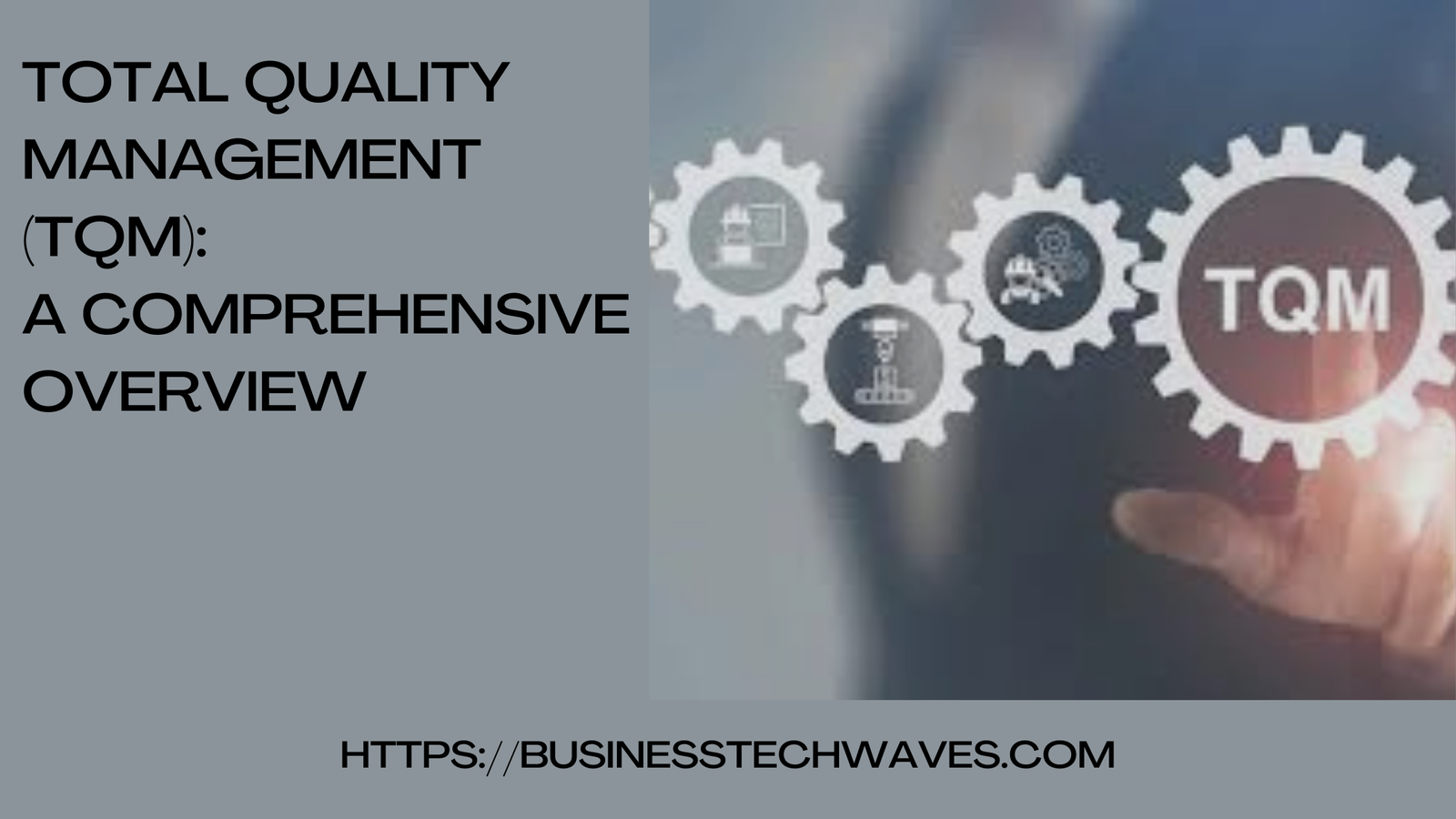
Total Quality Management Description (TQM): A Comprehensive Overview 2024
Total Quality Management Description (TQM) is a management philosophy that focuses on embedding quality in every aspect of an organization’s operations. Unlike traditional quality control methods, which focus on identifying defects in the final product, TQM emphasizes proactive involvement in improving the processes themselves to prevent issues before they arise. This article delves into the definition, history, principles, and benefits of TQM, illustrating its relevance in today’s dynamic business environment.
Definition of Total Quality Management
Total Quality Management is a holistic approach to long-term success through customer satisfaction. In essence, it demands that all members of an organization—from the CEO to the floor workers—actively participate in improving products, services, processes, and the culture in which they work. By continuously monitoring and improving business practices, TQM helps ensure that an organization meets or exceeds customer expectations while fostering a culture of continuous improvement.
The Evolution of TQM
TQM has its roots in the early 20th century, with the development of statistical quality control methods. However, it wasn’t until after World War II that Total Quality Management Description began to gain significant momentum. The Japanese manufacturing sector, with the guidance of experts such as W. Edwards Deming and Joseph Juran, embraced these new quality management philosophies. By integrating statistical methods and focusing on continuous improvement, Japanese companies quickly became leaders in global quality, particularly in the automotive and electronics industries.
In response to Japan’s success, Western companies began adopting Total Quality Management Description practices in the late 20th century. The principles of TQM were formally outlined and standardized with the development of quality management systems such as ISO 9000, which provided an international standard for managing quality.
Key Principles of Total Quality Management Description
TQM is based on several core principles that guide organizations in implementing a quality-first approach. These principles include customer focus, continuous improvement, employee involvement, process-oriented thinking, and integrated systems.
1. Customer Focus
The central tenet of TQM is that quality is defined by the customer. Rather than focusing solely on internal processes or profit margins, TQM emphasizes the importance of understanding customer needs and meeting or exceeding their expectations. Whether the customer is external (end users) or internal (departments or employees within the organization), all processes and efforts must align with delivering value to the customer.
2. Continuous Improvement
TQM promotes a philosophy of continuous improvement, often referred to by the Japanese term “Kaizen.” This principle is based on the idea that small, incremental changes over time can lead to significant improvements in performance and efficiency. Continuous improvement efforts are not confined to a single project or department but are integrated into the organization’s daily operations. This ensures that opportunities for enhancement are identified and acted upon regularly.
3. Employee Involvement
TQM recognizes that employees at all levels have a role in ensuring quality. A successful TQM system engages everyone in the organization, from senior leadership to front-line workers. Employees are encouraged to contribute ideas, identify problems, and participate in problem-solving initiatives. By empowering workers to take ownership of their processes, TQM fosters a sense of responsibility and involvement, leading to greater job satisfaction and motivation.
4. Process-Oriented Thinking
TQM stresses the importance of understanding and improving processes, as the quality of the output is determined by the effectiveness of the processes used to produce it. Every action, task, and decision can be viewed as part of a broader process that affects overall performance. By analyzing processes, organizations can identify inefficiencies, redundancies, and bottlenecks, which can then be improved or eliminated to ensure a smoother workflow and better results.
5. Integrated Systems
Total quality management description requires organizations to operate as integrated systems, where different departments and functions work collaboratively towards a common goal. Rather than operating in silos, each part of the organization must communicate and align its efforts with the overall mission and vision. This holistic approach ensures that all aspects of the organization are working towards the same objective, which is to deliver quality products and services to the customer.
The Benefits of Total Quality Management
Organizations that adopt TQM can experience numerous benefits, ranging from improved customer satisfaction to increased operational efficiency. The following sections highlight some of the key advantages of implementing a TQM system.
1. Enhanced Customer Satisfaction
Since TQM emphasizes meeting customer needs, it naturally leads to improved customer satisfaction. By focusing on quality at every stage of the process—from design and development to production and delivery—organizations can ensure that their products and services consistently meet or exceed customer expectations. Satisfied customers are more likely to become repeat buyers and brand advocates, contributing to long-term success.
2. Increased Operational Efficiency
TQM encourages organizations to optimize their processes, eliminate waste, and reduce variability. Through continuous improvement initiatives, businesses can identify inefficiencies in their operations and make necessary adjustments. This can lead to reduced costs, improved cycle times, and enhanced resource utilization. In competitive industries where margins are thin, the operational efficiencies gained from TQM can be a key differentiator.
3. Employee Engagement and Satisfaction
When employees are involved in quality improvement efforts, they are more likely to feel empowered and valued. TQM promotes a culture where workers are encouraged to contribute ideas and take ownership of their processes. This sense of involvement can lead to higher job satisfaction, lower turnover rates, and increased productivity. Moreover, a focus on quality often results in fewer rework tasks and a reduction in frustration caused by inefficient processes.
4. Improved Product and Service Quality
TQM aims to build quality into every aspect of the business, from design to delivery. By focusing on process improvement and defect prevention, organizations can reduce the number of errors and deliver higher-quality products and services. This focus on quality leads to better products, fewer customer complaints, and stronger brand loyalty.
5. Stronger Market Position
Organizations that consistently deliver high-quality products and services gain a competitive advantage. TQM helps companies build a reputation for reliability and excellence, which can translate into increased market share and customer loyalty. In today’s competitive marketplace, where consumers have a wide range of choices, businesses that prioritize quality are more likely to succeed.
Challenges of Implementing Total Quality Management Description
Despite its many benefits, implementing TQM can be challenging. Some of the common barriers to successful TQM adoption include:
1. Resistance to Change
TQM often requires significant changes in organizational culture, processes, and behavior. Employees, particularly those who are comfortable with the status quo, may resist these changes. Overcoming resistance to change requires effective communication, leadership, and training.
2. Time and Resource Investment
TQM is not a one-time initiative; it requires a long-term commitment from the organization. Implementing a comprehensive TQM system can be time-consuming and resource-intensive, as it involves training employees, redesigning processes, and continuously monitoring progress. Some organizations may struggle with the upfront costs and time required to fully implement TQM.
3. Misalignment with Organizational Goals
In some cases, there may be a misalignment between total quality management description initiatives and broader organizational goals. For example, if senior management is primarily focused on short-term profits, they may be less willing to invest in long-term quality improvements. Ensuring that TQM efforts are aligned with the organization’s strategic objectives is critical for success.
Conclusion
Total Quality Management is a powerful framework for improving an organization’s processes, products, and services. By emphasizing customer satisfaction, continuous improvement, employee involvement, and process optimization, Total quality management description helps businesses achieve long-term success in an increasingly competitive environment. While the implementation of TQM may present challenges, the benefits of enhanced efficiency, improved quality, and greater customer loyalty make it a worthwhile investment for organizations of all sizes.
In today’s globalized world, where consumer expectations are higher than ever, the principles of TQM are more relevant than ever. Companies that embrace total quality management description can expect to build a strong foundation for sustained growth, innovation, and market leadership.


